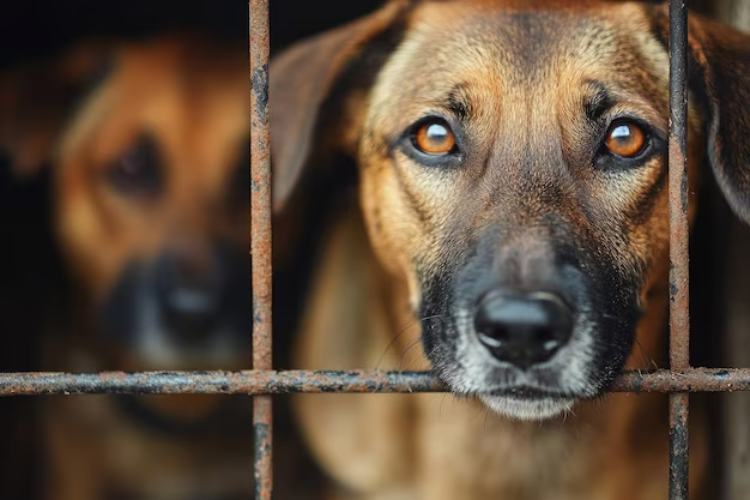Caring for and training an abused dog requires patience, compassion, and a deep understanding of the emotional and psychological trauma they have endured. Dogs that have been mistreated may display signs of fear, aggression, and anxiety, which can present challenges for even the most experienced pet owners. However, with the right approach, it is possible to rehabilitate an abused dog and help them regain trust in humans. In this comprehensive guide, we’ll explore how to train an abused dog by building trust, managing triggers, and using positive reinforcement to foster recovery.
Understanding the Effects of Abuse on Dogs
Abuse leaves deep emotional scars in dogs, manifesting in behavioral issues such as anxiety, aggression, and destructive habits. Abused dogs may exhibit abused dog signs, including excessive barking, chewing, digging, and attempts to hide or avoid human interaction. These behaviors often stem from heightened stress and a lack of trust in their surroundings.
Recognizing these signs is critical for developing an effective training plan. Can abused dogs be trained? Yes, but it requires a special approach that considers both the physical and emotional needs of the dog. Abused puppies and adult dogs alike may need specialized care and attention, often beyond basic obedience training, to address their traumatic experiences.
Key Signs of Abuse:
- Fearful behavior (cowering, shaking, or hiding)
- Avoidance of eye contact
- Aggression, growling, or snapping at humans or other animals
- Physical signs like scars, limping, or poor coat condition
- Hypervigilance or inability to relax
Preparing Your Home and Family
Before bringing an abused dog into your home, it’s essential to prepare a safe, comfortable environment that will help ease their anxiety. Start by creating a designated quiet space where your dog can retreat when feeling overwhelmed. This area should be free from excessive noise or activity, giving them a sense of security.
Involve your family in this preparation by educating everyone on how to interact gently and positively with the dog. Establishing a routine and setting clear boundaries will provide your new pet with much-needed stability. Be prepared for behavioral challenges, such as nervousness or avoidance, and develop a plan for how you will manage them using positive reinforcement.
Essential Tips for Preparing Your Home:
- Create a comfortable and secure area for your dog to relax.
- Educate family members on positive handling techniques.
- Establish a daily routine to provide consistency and comfort.
- Set up safety measures to prevent your dog from escaping due to anxiety.
Building Trust and Establishing a Bond
The cornerstone of rehabilitating an abused dog is building trust. This process requires time, patience, and a consistent, gentle approach. How to get an abused dog to trust you? Start by offering treats and affection at a pace your dog is comfortable with. Avoid forcing interactions; instead, let the dog come to you when they feel ready.
Positive reinforcement techniques, such as clicker training, can be particularly effective. Rewarding good behavior with treats or praise will help establish a bond and communicate that they are safe in their new environment.
Strategies for Building Trust:
- Begin with gentle interactions, such as offering treats.
- Use positive reinforcement, praising good behavior.
- Spend quality time together through activities like walking or playing.
- Be patient and allow your dog to adjust at their own pace.
Identifying and Managing Triggers
One of the critical steps in training an abused dog is identifying and managing their triggers. Triggers can include loud noises, unfamiliar people, or even certain gestures. Pay attention to what causes your dog to display signs of fear or aggression, and take steps to minimize exposure to these stressors.
In cases where avoidance isn’t possible, desensitization training can help your dog become more comfortable with triggers over time. This involves gradually introducing the stressful element in a controlled environment while using positive reinforcement to encourage calm behavior.
Managing Triggers:
- Identify specific triggers such as loud sounds or unfamiliar people.
- Provide a safe space where your dog can retreat when anxious.
- Gradually expose your dog to triggers in a controlled, calm setting.
- Use positive reinforcement to reward calm behavior in the face of triggers.
Training and Rehabilitation
Developing a tailored training plan for your abused dog is crucial for their recovery. Start with basic obedience commands like “sit,” “stay,” and “come.” These commands provide structure and help your dog understand what is expected of them.
Positive reinforcement, including clicker training, should remain at the heart of your strategy. As your dog becomes more confident, you can gradually introduce new commands or even more advanced activities like agility training or socialization exercises to promote their mental and emotional growth.
Rehabilitation Dog Training Tips:
- Use positive reinforcement methods such as clicker training.
- Focus on basic obedience to provide structure and security.
- Gradually introduce new training exercises as your dog gains confidence.
- Be patient, as rehabilitation can take time and effort.
Also Read: How to Train a Stray Dog
Addressing Emotional and Psychological Trauma
Abused dogs often suffer from deep emotional trauma, which manifests in conditions like anxiety, depression, or hypervigilance. Addressing these issues is essential for their long-term recovery. Providing a calm and secure environment is the first step.
Additionally, using desensitization techniques and plenty of positive reinforcement can help address the emotional scars your dog carries. Offering affection, consistent care, and reassurance can go a long way in making your dog feel loved and valued.
Emotional Support Tips:
- Create a safe, comfortable space for relaxation.
- Use desensitization and positive reinforcement to address anxiety.
- Provide affection and care to help your dog feel secure and loved.
Socialization and Integration
Socializing an abused dog is a delicate process that must be handled with care. Introduce your dog to new people, environments, and experiences slowly. Start with calm settings, using positive reinforcement to reward good behavior in unfamiliar situations.
Socialization helps your dog gain confidence and reduces their fear of new environments. Abused dogs may take longer to adjust, but patience and consistency are key. Always ensure that interactions with other animals and people are positive and stress-free.
Seeking Professional Help
Sometimes, the trauma an abused dog experiences requires the assistance of a certified dog trainer or behaviorist. If you find that the best way to train a dog for your dog’s behavioral challenges is too difficult to manage alone, seek professional help. An expert can create a specialized plan to train a dog, tailored to your dog’s specific needs
Working with a professional is not a sign of failure. On the contrary, it is a responsible step toward ensuring your dog’s recovery and well-being, as it might be the best way to train a dog effectively. Seeking expert help ensures you are using the right methods to train a dog successfully
Overcoming Challenges and Setbacks
It’s normal to face setbacks when training an abused dog. Recovery is not linear, and there will be days when progress feels slow. Don’t get discouraged. Instead, view setbacks as opportunities to learn more about your dog’s needs and adjust your approach.
Celebrate small victories, whether it’s your dog responding to a command or simply remaining calm in a stressful situation. These moments are signs of growth, and with time, your dog will continue to improve.
Conclusion
Training an abused dog requires time, patience, and empathy. By understanding their emotional and psychological needs, creating a safe environment, and using positive reinforcement training methods, you can help your dog overcome their trauma. While the road to recovery may be long, the bond you’ll build with your dog will be strong and unbreakable.







